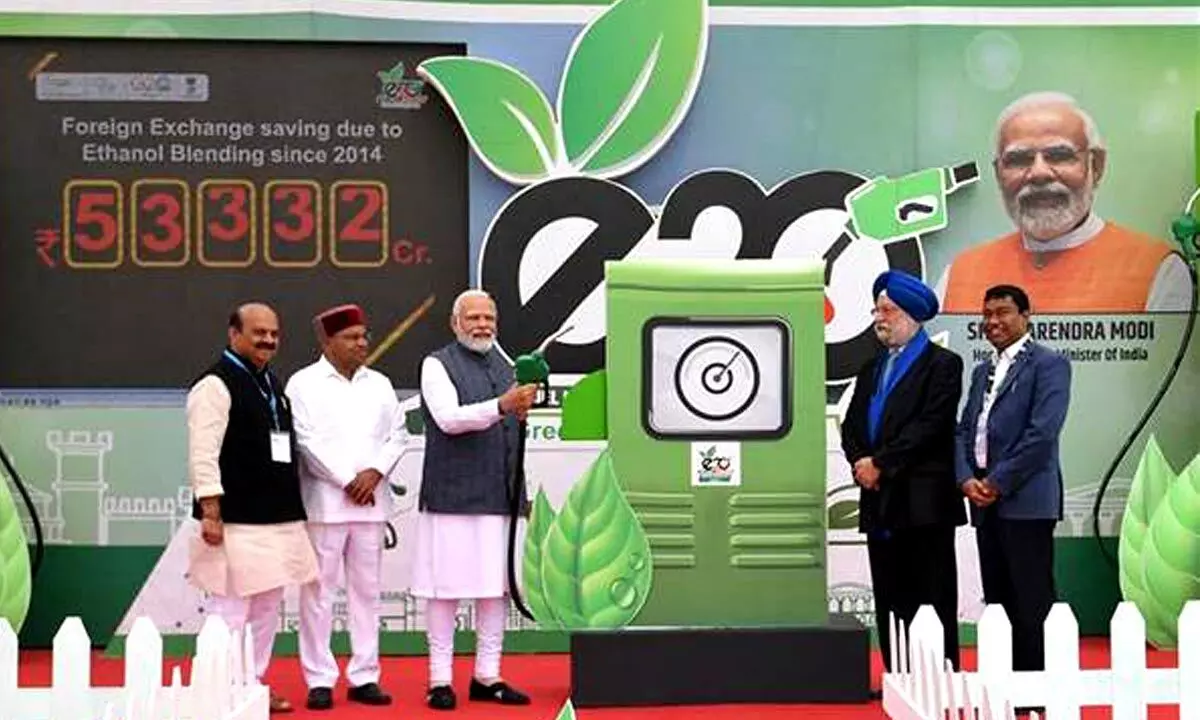India’s E20 blending initiative can save Rs 30,000 crore by 2025
Need for a phased launch of fuel blended with 20% ethanol (E20) to achieve 2025 target
image for illustrative purpose

India’s requirement of ethanol for petrol blending will increase to 1,016 crore litres in 2025-26. To meet this demand, the ethanol production capacity will have to be increased from 684 crore litres in 2019-20 to 1,500 crore litres. This includes production capacity of 740 crore litres of grain-based ethanol and 760 crore sugar-based ethanol. Fuel blended with 20% ethanol (E20) should be launched in a phased manner to ensure availability by 2025
The Union Government has targeted the E20 blending programme for vehicles by 2025, which is advancement by five years from an earlier 2030 target. It is estimated that a well laid-out and effective implementation of the E20 program can save the country up to $4 billion annually annually.
India has been a net importer of petroleum. It imported 185 Mt at US $ 551 billion in 2020-21, most of it being used for transportation.
Ethanol is a less polluting fuel and offers equivalent efficiency at a lower cost compared to petrol. Blending locally produced ethanol with petrol will help India strengthen its energy security, enable local enterprises and farmers to participate in the energy economy and also reduce vehicle emission.
Rising production of food grains and sugarcane, technological advancement in ethanol production from plant-based sources and SIAM working on the feasibility of making vehicles compliant to E20 ethanol-blended petrol, are a strategic requirement.
A favourable regulatory and retail ecosystem for the safe and effective use of ethanol-blended petrol has been put in place by various government agencies. OMCs have prepared their plans for the phased rollout of E20 blended petrol. Vehicle manufacturers have assured of making a similar plan for tweaking the engine and other parts to make the vehicle safe without compromising on the engine's efficiency.
India’s requirement of ethanol for petrol blending will increase from 173 crore litres in 2019-20 to 1,016 crore litres in 2025-26. To meet this demand, the ethanol production capacity will have to be increased from 684 crore litres in 2019-20 to 1,500 crore litres in 2025-26. This includes production capacity of 740 crore litres of grain-based ethanol and 760 crore sugar-based ethanol.
Fuel blended with 20% ethanol (E20) should be launched in a phased manner to ensure availability of E20 by 2025.
Ethanol production plants need environmental clearances for new projects and expansion of existing projects. The report recommends certain measures to expedite regulatory clearances for ethanol production like expediting consent to establish distilleries by state governments. Further, a single window system may be formulated by the Department for Promotion of Industry and Internal Trade to accord speedy clearances. This can facilitate speedy clearances for new projects and expansion of current projects for ethanol production.
Ethanol pricing and environmental impact: In 2018-19, the government introduced a differential pricing policy wherein higher rates were offered to sugar mills for ethanol production from B-heavy molasses (an intermediate product) and sugarcane juice. This incentivizes sugarcane-based ethanol production. One litre of ethanol from sugar requires about 2,860 litres of water. In view of the need for water conservation, the report recommended that suitable incentives should be used to (i) source ethanol from less water intensive crops and (ii) promote production from maize and second-generation sources.
The panel highlights that in order to use higher ethanol blends, vehicles need to be designed holistically to prevent engine failure and low fuel economy. Flex Fuel vehicles, though proven, would cost more than normal petrol vehicles. To ensure production of ethanol blended petrol compatible vehicles in the future, it recommended (i) E20 material compliant and E10 engine tuned vehicles may be rolled out across the country from April 2023 and (ii) rolling out vehicles with E20 tuned engines from April 2025.
Ethanol used for blending purposes is denatured ethanol (unfit for human consumption). The State governments are empowered to legislate, control, and levy taxes and duties on liquor meant for human consumption. However, the movement of denatured ethanol across India should not be under control of states to ensure unrestricted movement across India.
Ratings agency ICRA says that ethanol blending will reduce vehicular emissions, strengthen energy security, help reduce oil imports and conserve forex reserves. The other benefits include controlling excess sugar supply in the country, as approximately 65% of total ethanol production comes from molasses-based distilleries.
The Centre has targetted an increase in the share of gas in the energy mix up to 15% in 2030 to achieve a gas-based economy. Presently we are importing around 50% of the natural gas requirement.
India had commissioned 46 compressed biogas plants under SATAT (Sustainable Alternative Towards Affordable Transportation) scheme. Presently, around 100 outlets are dispensing compressed biogas across the country.

